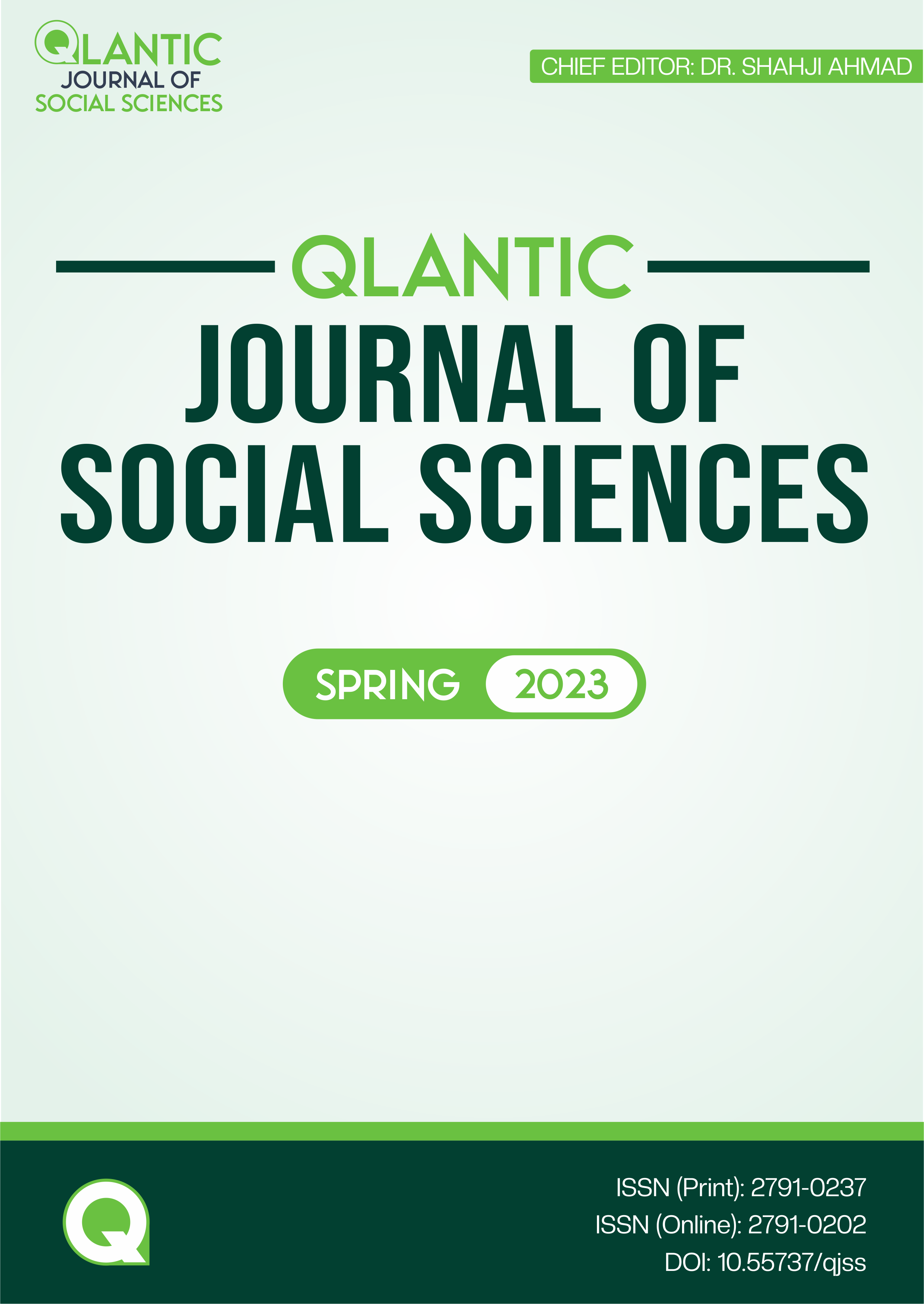Determinants of Non-Performing Assets and the Performance of Islamic Banks in Pakistan
DOI:
https://doi.org/10.55737/qjss.052156375Keywords:
Non-performing Assets (NPAs), FTDR, ROA, Tobin’s q Ratio, Bank Performance, Unconsolidated Financial Statements, Panel Least Square RegressionAbstract
These days non-performing assets have been essential factors in terms of the banking sector's profitability and sustainability. This study aims to weigh factors that may affect the surging level of non-performing assets in Pakistani Islamic banks. The study uses the Financing-to-deposit ratio (FTDR), Bank size, Return on assets (ROA), Inflation rate, and interest rate as the determinants of non-performing assets as banks' internal and external factors, respectively. The performance of Islamic banks is measured using Tobin’s Q ratio. Panel data from 2012 – 2022 was extracted from unconsolidated financial statements of Islamic banks and the World Bank database. Descriptive statistics, correlation, and panel least square regression analysis were used to find the relationship between non-performing assets (independent variable) and banks' performance (dependent variable). Data analysis is done through the EViews application software. The findings of this study revealed that there is a significant impact of different factors of non-performing assets on the performance of Islamic banks in Pakistan. The results of the analysis concluded that banks' performance can be increased by reducing the level of non-performing assets. The study will benefit the management of Islamic banks in considering these factors to improve their performance by controlling the level of NPAs.
References
Agrawal, R. B., & Goyal, M. (2021). Non-Performing Assets of Banks: A Literature Review PJAEE, 18 (10) (2021) “Non-Performing Assets of Banks: A Literature Review.” 18(10), 330–340. https://doi.org/10.31305/rrijm.2021.v06.i05.022
Alamelu, K., & Chandran, S. R. (2018). Issn : 2278-6236 Trends in Non-Performing Assets of Public Sector Banks. International Journal of Advanced Research in Management and Social Sciences, 7(8), 66–80.
Aniket Pundir Et all. (2021). A Systematic Review on Non-Performing Assets in Banks in India. Turkish Journal of Computer and Mathematics Education (TURCOMAT), 12(2), 177–184. https://doi.org/10.17762/turcomat.v12i2.699
Apriyanti, R., Asmak A. B., Rahman, & Maharani, S. (2021). Empirical Studies of the Effect of Operational Costs and Operating Income, Financing To Deposit Ratio Against Return on Asset With Non-Performing Financing As Intervening Variables in Sharia Bank Indonesia 2013-2020. Niqosiya: Journal of Economics and Business Research, 1(1), 21–36. https://doi.org/10.21154/niqosiya.v1i1.78
Arsew, V. T., kisman, Z., & Sawitri, N. N. (2020). Analysis of the Effect of Loan to Deposit Ratio, Non-Performing Loans and Capital Adequacy Ratio on Return on Assets with Good Corporate Governance as Intervening Variable in Banking Companies Listed in the Corporate Governance Perception Index (CGPI) for. Journal of Economics and Business, 3(1), https://doi.org/10.31014/aior.1992.03.01.182
Bolat, S., & Isik, O. (2016). Determinants of non-performing loans of deposit banks in Turkey. Pressacademia, 5(4), 341–350. https://doi.org/10.17261/pressacademia.2017.356
Boru, T. (2018). CHAPTER FIVE RESEARCH DESIGN AND METHODOLOGY 5 . 1 . Introduction. CHAPTER FIVE RESEARCH DESIGN AND METHODOLOGY 5.1. Introduction, December, 41. https://doi.org/10.13140/RG.2.2.21467.62242
Burro, R. (2016). To be objective in Experimental Phenomenology: a Psychophysics application. SpringerPlus, 5(1), https://doi.org/10.1186/s40064-016-3418-4
Chaibi, H. (2016). Determinants of Problem Loans: Non-performing Loans vs. Loan Quality Deterioration. International Business Research, 9(10), 86-91. https://doi.org/10.5539/ibr.v9n10p86
Denzin, N. K. (2001). The seventh moment: Qualitative inquiry and the practices of a more radical consumer research. Journal of Consumer Research, 28(2), 324–330. https://doi.org/10.1086/322907
Duraisamy, J. (2016). Impact of non-performing assets on return on assets of public and private sector banks in India.
Garg, A. (2020). A Study on Management of Non-Performing Assets in Context of Indian Banking System. International Journal of Engineering Technologies and Management Research, 3(11), 15–25. https://doi.org/10.29121/ijetmr.v3.i11.2016.68
Guba, E. G., & Lincoln, Y. S. (1994). 02 Competing paradigms in qualitative research. Handbook of Qualitative Research, 163–194.
Jameel, K. (2014). Crucial factors of non-performing loans evidence from Pakistani banking sector. International Journal of Scientific & Engineering Research, 5(7), 704–710. http://www.ijser.org
Kartika, R., Jubaedah, S., & Astuti, A. D. (2020). The Influence of Financing to Deposit Ratio, Return on Assets and Non Performing Finance on Profit Sharing Finance of Sharia Banks in Indonesia. 123(Icamer 2019), 136–140. https://doi.org/10.2991/aebmr.k.200305.034
Khan, I., Ahmad, A., Khan, M. T., & Ilyas, M. (2018). The impact of GDP , inflation , exchange rate, unemployment and tax rate on the non performing loans of banks: Evidence from Pakistani commercial banks. Journal of Social Sciences and Humanities, 26(1), 141–164.
Khan, V. J., Kumar, B., Fani, K. A., Pk, B. K., Bank, B., Rajshahi, B., Khurram, A., Fani, V. J., Khan, B., Kumar, B., & Kumar, P. (2018). Impact of Internal and External Factors on Bank Performance in Pakistan. Article in Journal of Public and International Affairs, 2(4), 66–77. https://doi.org/10.11648/j.ipa.20180204.11
Magout, M. (2020). CHAPTER THREE – Research Methodology. A Reflexive Islamic Modernity, 57–84. https://doi.org/10.5771/9783956506376-57
Mohanty, A. R., Das, B. R., & Kumar, S. (2018). Determinants of Non-Performing Loans in India: A System GMM Panel Approach. Prajnan , 47(1), 37–56. http://pib.nic.in/focus/fomore/narsim.html.
Murali, S. B., Basit, A., & Hassan, Z. (2017). Impact of job stress on employee performance. International Journal of Accounting & Business Management, 5(2), 13–33.
Saeed, R., Nayyab, H. H., Rashied, H., Lodhi, R. N., Musawar, S., & Iqbal, A. (2013). Who is the most potential entrepreneur? A case of Pakistan. Middle East Journal of Scientific Research, 17, 1307–1315. https://doi.org/10.5829/idosi.mejsr.2013.17.09.12296
Sana, A., Fayaz, M., & Ullah, R. (2019). Linking Non-Performing Loans with Organizational Performance: Evidence from Banking Sector of Pakistan. Global Economics Review, IV(IV), 35–44. https://doi.org/10.31703/ger.2019(iv-iv).04
Senthil Arasu, B., Sridevi, P., Nageswari, P., & Ramya, R. (2019). A Study on Analysis of Non-Performing Assets and its Impact on Profitability. International Journal of Scientific Research in Research Paper. Multidisciplinary Studies, 6, 1–10. www.moneycontrol.com.
Shah, M., Ullah, H., & Khalid, S. (2012). A Comparative Study of Credit Risk in Different Companies of Different Sectors in Pakistan. International Journal of Academic Research in Business and Social Sciences, 2(1), 615–626. www.hrmars.com/journals
Thakur, S. S. (2018). A Review of the Theoretical Framework for Non- Performing Loans and their Determinants. 5(12), 278–283.
Waqas, M., Fatima, N., Khan, A., & Arif, M. (2019). Determinants of Non-performing Loans. International Journal of Finance & Banking Studies (2147-4486), 6(1), 51–68. https://doi.org/10.20525/ijfbs.v6i1.617




